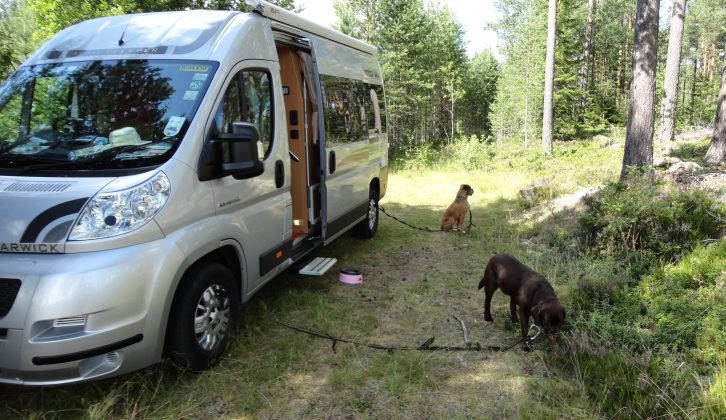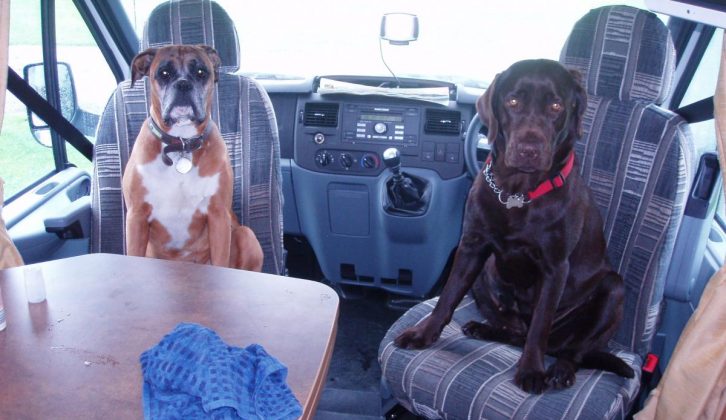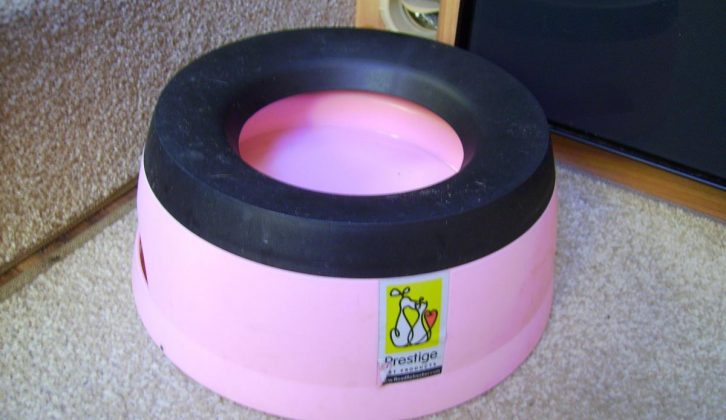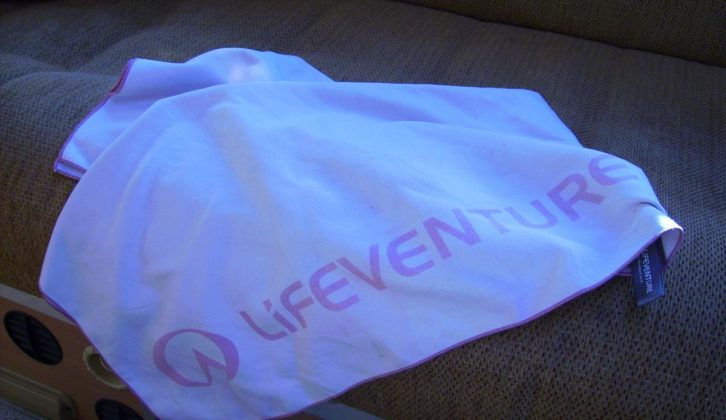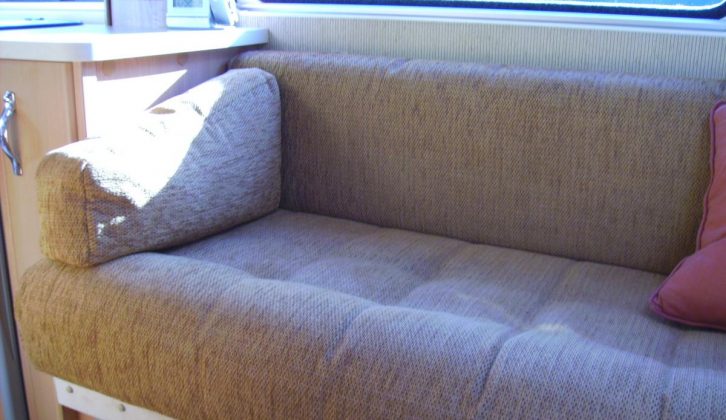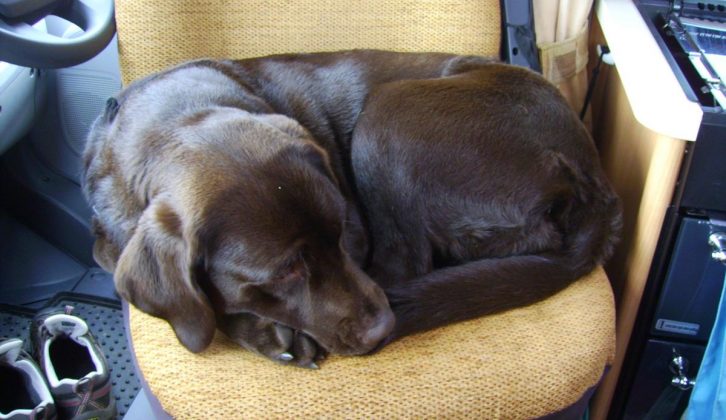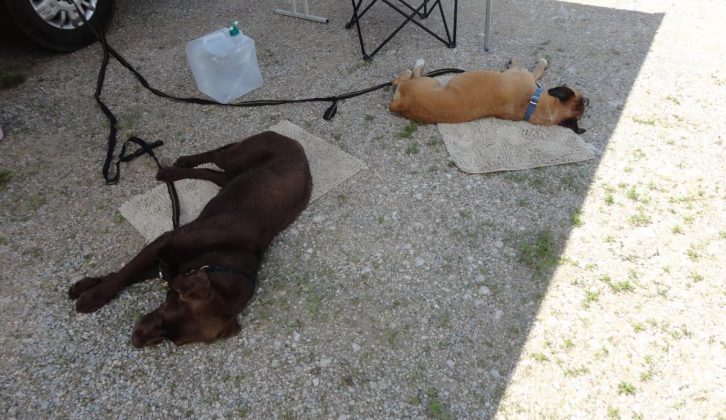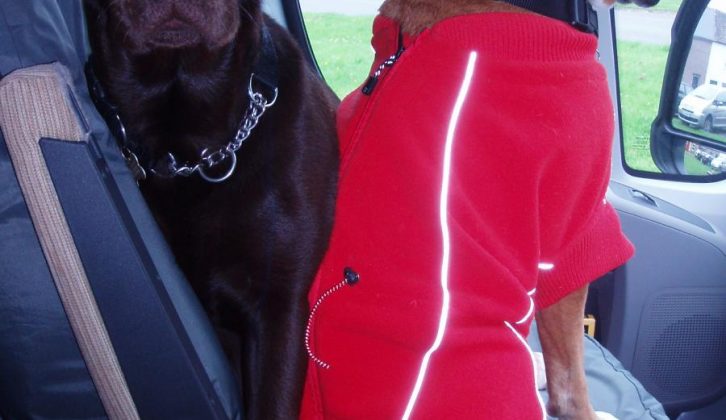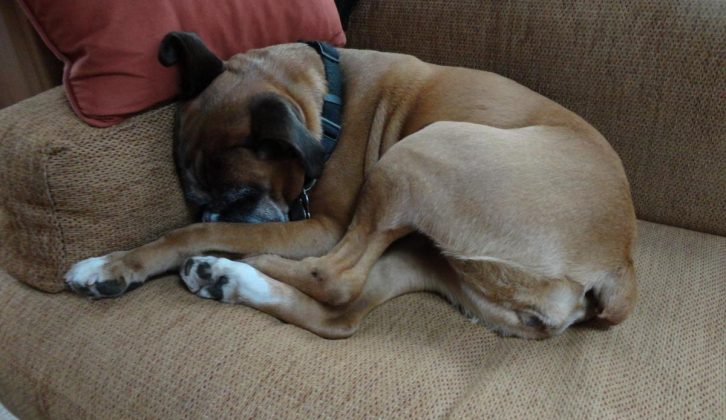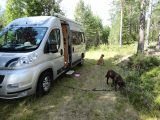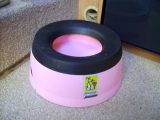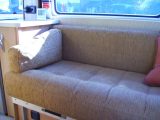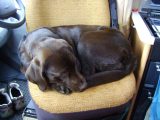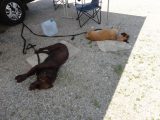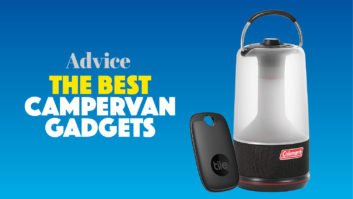Some might say that our two dogs are spoilt – and they’d be right. My wife, Chrissie, and I get more back from them than we’d ever bargained for; they truly enrich our lives. They’ve joined us on our travels as much as possible over the years, be it when we’re camping, in B&Bs or even in hotels. So when we considered buying a motorhome, how the dogs would take to it was high on our list of concerns.
Try before you buy is, therefore, my first tip. Our first move was to hire a ’van before taking the plunge. There are lots of motorhomes for hire and we were pleased that an internet search revealed lots of dog friendly rental companies. We had no problems with our two: they took to life with a ’van like the proverbial ducks to water.
Before we go any further, I should point out that our dogs are big and bouncy. They’re a Boxer and a large, silly Labrador. They are also far from the best-behaved pooches you’re ever likely to meet. We can cope with them in our modestly sized panel van conversion, an Auto-Sleeper Warwick Duo, so your obedience-trained Yorkshire Terrier will be just fine, no matter what your size of vehicle.
A major consideration is the safety of your dogs while you’re on the road. Several manufacturers make dedicated harnesses that are designed to secure dogs in a vehicle: these are purpose-made and attach to seat belts or similar points in the ’van.
A bit like babies, dogs require an array of paraphernalia to cater for their needs when on tour. Most important is water, which should be available at all times. The Road Refresher water bowl that we use has been designed for use in a moving vehicle, avoiding tipped bowls and the ensuing minor flood. Having kept the dogs topped up with water, make sure you take regular breaks, especially on longer trips. All dogs’ needs vary, of course, but we’d recommend stopping at least every hour to let them do their duties.
Dogs do get mucky, but the ability to clean them is key to coping on the road. We regularly make use of the tap that’s provided for rinsing away waste water at motorhome service points. Maybe you could consider carrying a short length of hose specifically for this purpose. If no tap is available, a bucket and cloth will suffice – we use a folding bucket to save space.
However, perhaps the biggest problem you’ll face is getting the dogs dry. As seasoned lightweight travellers, we long ago discovered the value of travel towels made from microfibre fabric. We use Lifeventure’s large SoftFibre Trek towels, and have four of these in the motorhome for our two dogs. They take up next to no space, too. Make sure you hang them up to dry as soon as you’ve used them, and resist the temptation to wash them after every use – they’re still effective as dog towels once dry, even when mucky. They wash easily and dry quickly, but beware, most campsites ask you not to put doggy stuff in the washing machines.
As previously mentioned, we cope just fine with two large-ish dogs in our long-wheelbase panel van conversion, but we’re not over-endowed with floor space. Our motorhome has a pair of single-bed-sized sofas – allowing the dogs on them may seem foolish but, as long as they’re clean, we find they are less in the way than if they were constantly under our feet in the relatively narrow corridor of our living space. They soon learned to curl up, which leaves room for the two of us, feet up on each sofa, with a dog at one end.
You’ve probably noticed that many manufacturers seem to favour light-beige tones for their soft furnishings. Such colours aren’t well suited to dogs, especially thick-coated, often muddy Labradors! Our motorhome fitted all our needs really well, except for the soft furnishings, so high on our list of priorities was a set of removable, washable covers.
Also, we’ve found it imperative to train the dogs to only use the side, habitation door. We never let them in or out of the cab or rear doors. By doing this, our lively dogs don’t see a cab or rear door opening as an invitation to dash through the gap; meaning that we can sit with our rear doors open, without fear of the rapid exit of a boisterous hound. Similarly, when exiting via the cab doors at a site office or shopping stop, we’re not fending off offers of help from our pets.
If you’re considering taking your dog on your motorhome holidays, you should ask yourself how he or she will cope in the ’van on his/her own. Ours are used to being left in the house and the back of our estate car, so it wasn’t a massive leap for them to adjust.
Good ventilation is vital, but thankfully it’s a lot easier in a motorhome than a car: you can usually open roof vents wide without compromising security too greatly. With their dogs in mind, friends of ours have fitted a thermostatic roof-extractor fan, which kicks in above a pre-set temperature.
Incidentally, our two dogs often take up key positions – one on each front seat – while we’re shopping in the supermarket. This frequently elicits questions from passers-by about their driving abilities: I think that the Lab is nearly as good as me, but that the Boxer hasn’t a clue!
Quite understandably, all campsites have rules about guests needing to keep their dogs safely secured. We have tethers in the motorhome, made from lengths of the cheapest climbing tape readily available, which have been cut to length from a roll by an outdoor shop. The lengths have a carabiner on the end, but a cheaper option is the kind of steel snap-link available from B&Q or similar. These can be secured to one of the screw spikes that are sold for the purpose, but we prefer to loop them around a spoke of our alloy wheels. If you don’t have alloys, take a look around your motorhome – towing eyes, tow bars or similar can provide a suitable attachment point.
Of course, remember that not everyone likes dogs, so do your best to discourage them from barking. Sometimes that’s easier said than done, but a water pistol can have its uses as a humane deterrent! Use designated dog walks where provided, rather than just walking around the campsite allowing your canine to mark his territory over your neighbour’s new awning. And you should, of course, be sure to pick up all dog mess and dispose of it safely. Do your best to present a good front on behalf of dog-lovers, and you’ll be doing us all a favour in the long run.
When it comes to keeping our hounds fed, we carry around five days’ supply of food for the dogs. We try to adhere, as far as possible, to the same feeding times as at home, so the dogs get used to being in the ’van as part of their normal routine.
Routine is also crucial when it comes to bedtime. Think about where your dogs will sleep. Our ’van has a rear lounge/bedroom. We often sleep in single beds, and both dogs are happy to snuggle together on the floor between them. We put down sleeping pads so they know that’s their space.
Of course, this changes if we decide to make up the double bed. The Boxer, Dixie, likes to crawl under the middle of the bed, but our Lab, Tilly, prefers to spread out on the floor between the kitchen and bathroom – except when we let them up on the bed with us. Given that our double is king-sized there’s more than enough room, but far be it for me to advocate this as sensible behaviour! Let’s just say, make sure your dogs know where they’re supposed to be sleeping and consider marking that with some form of bed.
If you have a larger motorhome, there are more possibilities. The cleverest I’ve seen was a ‘van with a garage under the rear fixed bed. The owners had made a door with an open mesh grille in it, beneath the bed, so the dog could access the garage from inside the ’van and sleep in there. If you have a stand-alone awning, you could use that as a doggy bedroom – just make sure the animal is warm enough, as even summer nights can be chilly. This option could work well in conjunction with a puppy cage, which can be made very comfortable for overnight use.
In cold weather, keeping the dogs warm at night can be a real issue. Our short-coated Boxer feels the cold much sooner than the Lab, so we often put her warm, fleece coat on at night. You might also consider leaving the heating on overnight, especially if you’re on an electric hook-up. Checking our Boxer’s ears gives a quick clue to her temperature: if they feel cold, we need to think about warming her up.
If choosing a ’van with dogs in mind, you might want to veer towards a layout that allows easy access to the door at night, just in case your hound gets caught short. So a front-lounge panel van, where the made-up bed blocks the side door, might quickly be ruled off your shopping list, when looking for motorhomes for sale.
Going abroad? Then you’ll need pet passports. Essentially your dogs must be microchipped, have a rabies vaccination and a pet passport, and be treated for tapeworm before returning to the UK. You may not re-enter the UK until 21 days after the rabies vaccination. You must also travel with an ‘authorised carrier’; so you can forget that invitation to join your millionaire uncle on his ocean-going yacht! This is only an overview, though: full details are available on the UK government’s website.
And don’t forget to check the requirements in specific countries, particularly those outside the EU. Microchipping is mandatory for travel abroad, but make sure you also have mobile phone numbers on the dogs’ tags, including the country code, so you’re contactable if you and your pet become separated. And in hotter climes, we’ve found that the shade offered by a wind-out awning is essential to keep your dogs (and you) from overheating.
We hope we’ve given you the confidence to tour with your dog. On most campsites you can reckon on the fact that around 50% of caravan and motorhome owners will have their pampered pet with them, so you’ll be in good company. Take the plunge, and give both yourself and your dog a real holiday to remember.
Try before you buy is my first tip
